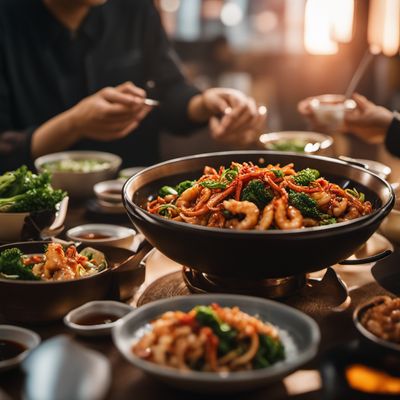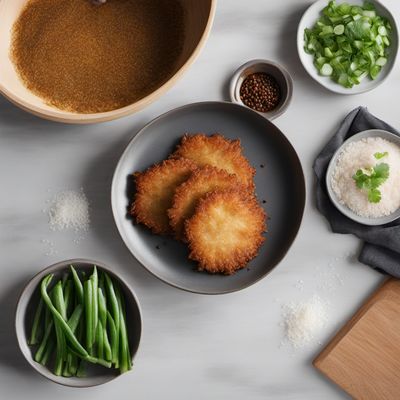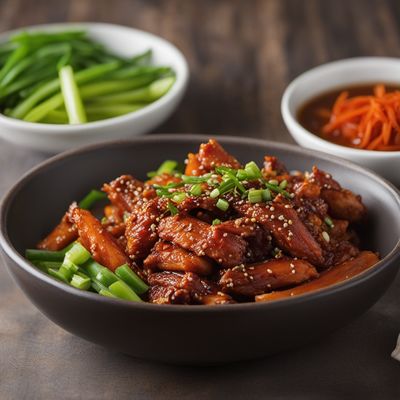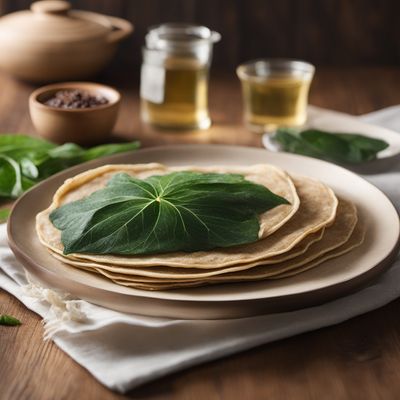
Recipe
Kimchi Adapted to Spanish Cuisine
Spanish-Inspired Kimchi: A Fiery Twist on a Classic
4.8 out of 5
In the vibrant world of Spanish cuisine, we introduce a fiery twist on the beloved Korean dish, kimchi. This adaptation combines the bold flavors of traditional kimchi with Spanish ingredients, resulting in a fusion that will tantalize your taste buds. Get ready to embark on a culinary adventure that marries the best of both worlds.
Metadata
Preparation time
30 minutes
Cooking time
5 minutes
Total time
35 minutes (excluding fermentation and refrigeration time)
Yields
4 servings
Preparation difficulty
Medium
Suitable for
Vegetarian, Gluten-free, Dairy-free, Low-carb, Paleo
Allergens
Chorizo (pork)
Not suitable for
Vegan, Nut-free, Soy-free, Egg-free, Shellfish-free
Ingredients
While the original Korean kimchi is known for its pungent and spicy flavors, this Spanish-inspired version incorporates elements of Spanish cuisine. We use Spanish paprika, chorizo, and sherry vinegar to infuse the kimchi with a smoky and tangy twist. The result is a unique blend of flavors that pays homage to both culinary traditions. We alse have the original recipe for Kimchi, so you can check it out.
-
1 medium Napa cabbage (500g) 1 medium Napa cabbage (500g)
-
2 tablespoons sea salt (30g) 2 tablespoons sea salt (30g)
-
1 tablespoon Spanish paprika (15g) 1 tablespoon Spanish paprika (15g)
-
2 cloves garlic, minced 2 cloves garlic, minced
-
1 tablespoon grated fresh ginger (15g) 1 tablespoon grated fresh ginger (15g)
-
1 tablespoon sherry vinegar (15ml) 1 tablespoon sherry vinegar (15ml)
-
1 tablespoon honey (15ml) 1 tablespoon honey (15ml)
-
1/4 cup chopped Spanish chorizo (40g) 1/4 cup chopped Spanish chorizo (40g)
-
2 scallions, thinly sliced 2 scallions, thinly sliced
-
1 carrot, julienned 1 carrot, julienned
-
1/2 red bell pepper, thinly sliced 1/2 red bell pepper, thinly sliced
-
1 tablespoon olive oil (15ml) 1 tablespoon olive oil (15ml)
Nutrition
- Calories: 120 kcal / 502 kJ
- Fat: 7g (Saturated Fat: 2g)
- Carbohydrates: 12g (Sugar: 6g)
- Protein: 3g
- Fiber: 4g
- Salt: 2g
Preparation
-
1.Cut the Napa cabbage into quarters and remove the core. Slice the cabbage into thin strips.
-
2.In a large bowl, combine the cabbage and sea salt. Massage the salt into the cabbage for about 5 minutes to help release its juices. Let it sit for 30 minutes.
-
3.Rinse the cabbage under cold water to remove excess salt. Squeeze out any remaining liquid and transfer the cabbage to a clean bowl.
-
4.In a small bowl, mix together the Spanish paprika, minced garlic, grated ginger, sherry vinegar, and honey to create a paste.
-
5.Heat olive oil in a pan over medium heat. Add the chopped Spanish chorizo and cook until crispy. Remove from heat and let it cool.
-
6.Add the chorizo, scallions, carrot, and red bell pepper to the bowl with the cabbage. Pour the paprika paste over the vegetables and mix well, ensuring all the ingredients are coated.
-
7.Transfer the kimchi to a clean jar, pressing it down firmly to remove any air bubbles. Seal the jar tightly and let it ferment at room temperature for 2 to 3 days.
-
8.After the fermentation period, refrigerate the kimchi for at least 1 week before consuming to allow the flavors to develop.
Treat your ingredients with care...
- Napa cabbage — Make sure to thoroughly rinse the cabbage after massaging it with salt to remove excess saltiness.
- Spanish paprika — Opt for a high-quality smoked Spanish paprika to enhance the smoky flavor of the kimchi.
- Spanish chorizo — Use cured Spanish chorizo for a rich and robust taste.
- Sherry vinegar — If you can't find sherry vinegar, you can substitute it with red wine vinegar.
- Honey — Adjust the amount of honey according to your desired level of sweetness.
Tips & Tricks
- For a spicier kick, add a pinch of Spanish cayenne pepper or crushed red pepper flakes.
- Allow the kimchi to ferment for longer if you prefer a stronger and more tangy flavor.
- Serve the kimchi as a side dish to complement Spanish tapas or as a topping for grilled meats and sandwiches.
- Store the kimchi in the refrigerator for up to 1 month to maintain its freshness.
- Experiment with different vegetables like radishes or bell peppers to add your own twist to the recipe.
Serving advice
Serve the Spanish-inspired kimchi as a vibrant and flavorful side dish alongside traditional Spanish tapas. It pairs exceptionally well with grilled chorizo, patatas bravas, and Spanish omelette. The tangy and smoky flavors of the kimchi will add a delightful contrast to the rich and savory Spanish dishes.
Presentation advice
Present the Spanish-inspired kimchi in a small ceramic dish or a glass jar to showcase its vibrant colors. Garnish with a sprinkle of chopped scallions or a drizzle of olive oil for an extra touch of elegance. Serve with a side of crusty bread or tortilla chips for a complete sensory experience.
More recipes...
For Kimchi » Browse all
For Korean cuisine » Browse all
More Korean cuisine dishes » Browse all

Boribap
Barley rice
Boribap is a traditional Korean dish made with rice, vegetables, and meat. It is a type of bibimbap that is served in a hot stone bowl.

Ojingeo chae bokkeum
Spicy Squid Stir-Fry
Ojingeo chae bokkeum is a Korean stir-fry dish that is made with squid and vegetables. It is a popular dish in Korean cuisine.

Agujjim
Spicy Grilled Fish
Agujjim is a spicy Korean fish stew that is perfect for a cold winter day. It is a hearty and flavorful dish that is sure to warm you up.
More Spanish cuisine dishes » Browse all

Chorizo al vino
Chorizo al vino is a Spanish dish that is made with chorizo sausage and red wine. The dish is typically served as a tapa or appetizer and is known...

Carrillada
Pork cheek
Carrillada is a Spanish dish made from beef cheeks that are slow-cooked in a flavorful sauce. The dish is known for its tender and juicy meat that...

Quesada pasiega
Quesada Pasiega
Quesada pasiega is a traditional Spanish dessert that originated in the region of Cantabria. It is a rich and creamy dessert that is perfect for...











